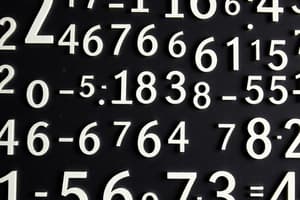Podcast
Questions and Answers
On a number line, where is the value of -3 located?
On a number line, where is the value of -3 located?
- To the right of 0
- To the left of -1
- To the left of -2 (correct)
- To the right of -4
Which of the following numbers is an irrational number?
Which of the following numbers is an irrational number?
- 1/2
- 0
- -5
- √2 (correct)
In the ordering of real numbers, which statement is true?
In the ordering of real numbers, which statement is true?
- -1/2 > -1
- -3.5 < -3
- -4 > 0
- -7 < -5 (correct)
If a and b are rational numbers, which statement is true about their ordering?
If a and b are rational numbers, which statement is true about their ordering?
If x is a negative real number and y is a positive real number, what can we say about their relative positions on the number line?
If x is a negative real number and y is a positive real number, what can we say about their relative positions on the number line?
Which set of numbers includes both positive and negative whole numbers?
Which set of numbers includes both positive and negative whole numbers?
What type of numbers can be expressed as the quotient of two integers?
What type of numbers can be expressed as the quotient of two integers?
Which type of numbers cannot be expressed as a simple fraction?
Which type of numbers cannot be expressed as a simple fraction?
What is an example of an irrational number?
What is an example of an irrational number?
Which type of number can be represented as repeating decimals?
Which type of number can be represented as repeating decimals?
Where do integers fall on a horizontal number line?
Where do integers fall on a horizontal number line?
Flashcards are hidden until you start studying
Study Notes
Real Numbers
Real numbers are the set of all numbers, including integer values, fractional values, and numbers that cannot be expressed as a simple fraction. They are used in many fields of mathematics and science, especially in calculus and physics.
Integers
Integers are whole positive and negative numbers, such as 2, -3, 0, and so forth. They can be represented along a horizontal number line without gaps between them. This is why they are also known as counting numbers or natural numbers when going from left to right. There are infinitely many integers of both positive and negative signs.
Rational Numbers
Rational numbers are any number which can be expressed as the quotient (fraction) p/q of two integers, where p is called the numerator and q is called the denominator; the sum of the magnitudes of p and q is nonzero. For example, 2, 3, 3/2, 7/9, and 22/7 are all rational numbers. These fractions have repeating decimals. Integers are just special cases of rational numbers where the denominator (denominator = 1).
Irrational Numbers
Irrational numbers are those numbers which do not fit into any pattern or formula. A well-known example of an irrational number is π (pi), which is approximately equal to 3.14159. Another example is the square root of 2 (sqrt(2)), which is approximately equal to 1.41421. While these numbers are not expressible as a finite decimal, they can still be represented as infinite, often repeating, decimals.
Number Line
The number line is a visual representation of real numbers using points and arrows. It goes from the smallest possible value, usually denoted as -∞ (negative infinity), and extends to the largest possible value, denoted as +∞ (positive infinity). Numbers above the origin (0) are considered positive, while numbers below it are negative. From left to right, the number line represents the order of the real numbers, with smaller numbers representing positive numbers.
Ordering of Real Numbers
Ordering is an important concept in understanding the properties of the real numbers. The ordering of real numbers allows us to determine if one number is larger than another by comparing their magnitudes. For example, 2 > 1 because 2 has a larger magnitude than 1. This property holds true for integers and rational numbers as well, allowing for comparisons like 3 > 2 and 4/3 < 1.5.
Studying That Suits You
Use AI to generate personalized quizzes and flashcards to suit your learning preferences.




